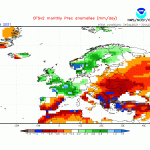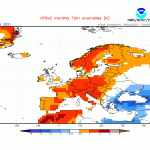
According to climate data, the mean temperature in October is of 21.4°C (a 24.8°C high and a 17.9°C low). Total precipitation in October climatically amounts to 83.3 mm. October is the second month of meteorological autumn, and as such is marked by the gradual cooling down of air temperatures and episodes of thundery showers which are often intense and deposit large amounts of rain in a short period of time clique neste link.
After careful study of long-term seasonal models, we’re expecting October 2021 to be overall warmer than the norm. Taking the national average, rainfall is expected to be around average. Long-term seasonal models suggest that whilst temperatures will be on a general decline, the flow of warm, stable air from the south means that values will be at least slightly above average much of the time. Nighttime lows will remain particularly warm, under the influence of a very warm central Mediterranean sea. The very warm sea maintains increased rates of evaporation from the sea. The very warm sea is one of several ingredients required for copious rainfall from autumn storms. Another essential factor are incursions of cold air from the north. We’re expecting these to penetrate the central Mediterranean on occasion, meaning episodes of instability should not be lacking. An ‘Average’ outlook means that maps are pointing towards normal thunderstorm activity around the central Mediterranean. Whether or not a month ends up being drier or wetter than average will depend on whether any thunderstorms that form affect land or not. This is because one or two stormy episodes and one or two misses, may easily produce plentiful precipitation, pushing values to above or below average respectively.
- Long-term seasonal model for precipitation in October 2021
- Long-term seasonal model for temperature in October 2021
FURTHER OUTLOOK (TEMPERATURE) FOR NOV-DEC-JAN 2021/2022 – Warmer than Average
FURTHER OUTLOOK (PRECIPITATION) FOR NOV-DEC-JAN 2021/2022 – Average*
* An ‘Average’ outlook means that maps are pointing towards normal thunderstorm activity around the central Mediterranean. Whether or not a month ends up being drier or wetter than average will depend on whether any thunderstorms that form affect land or not. This is because one or two stormy episodes may easily produce plentiful precipitation, pushing values to above average. Conversely, one or two near misses may leave the Maltese Islands land area dry, pushing values to below average.
Disclaimer: Specific details on the weather may only be given for a couple of days in advance. This long-term forecast is not meant to determine specific weather parameters at a point on the Maltese Islands. Instead, it looks at large scale weather patterns across Europe, and attempts to determine how these may influence the weather locally. Our levels of confidence in the forecast for the month ahead are fair. These are reasonably lower when it comes to the ‘Further Outlook’ section. Weather forecasts are an interpretation of possible weather events based on trends, maps and climate data at the time of the forecast, and as a result, weather predictions may always change over time. Maltese Islands Weather can never be held responsible for any direct, indirect, incidental, consequential, special or exemplary damages or even lost profit resulting from any use or misuse of this data. The user assumes the entire risk related to the use or misuse of this data.




0 comments
Write a comment